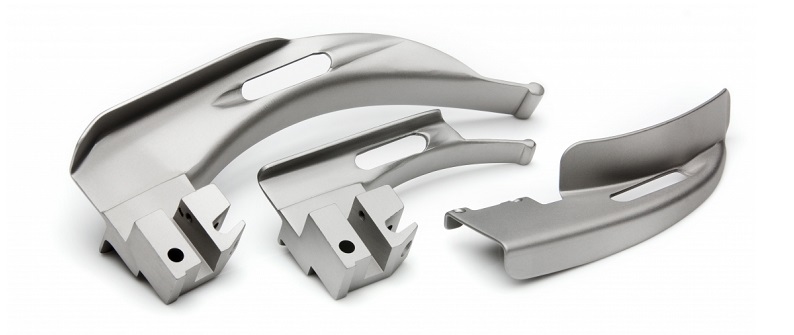Low-pressure, high-volume water washing with appropriate cleaning chemicals is a well-recognised ‘solvent cleaning’ method. Component cleaning may involve anything from nuts and bolts to complete turbine generators.
And component complexity can vary from simple spindles to sophisticated electrical assemblies. Materials can include any metal or alloys, including additive manufactured (AM) components - wet blasting is particularly good at cleaning the complex channels frequently found in AM components. Composites like carbon fibre can be cleaned as well to produce perfect surfaces for composite bonding.

Medical industry Larynscope blades cleaned to a specific Ra that is perfect for sterlisation after use
Our wet blasting machines (also known as vapor blasting machines) are able to remove a variety of solvents from light oil to heavy grease. Vapor blasting will also remove rust, scale, carbon, paint, chemical deposits, general dirt and heat discolouration. Solvents like mineral spirits can be used to remove solvent-soluble foreign matter from the surface of ferrous metals.
The acceptable surface finishing of a component after cleaning can range from unchanged from the original surface finish, to lightly etched, or even in some cases, to the removal of the surface skin to a controlled degree.
Our vapor blasting technology can even produce a highly clean surface to consistent Ra surface roughness.

Various aerospace industry cleaned by wet blasting
Vapor blasting has the ideal set of characteristics for the surface cleaning of metals and composites:
For consistent uniform and repeatable vapor blasting we have a range of automatic vapor blasting machines with highly intuitive, simple to use HMIs. Once the cleaning programme is set up a simple press of a button is all that is required once components are loaded into the vapor blasting chamber.
Automatic machines produce a highly repeatable and consistent result, so you can be assured the entire component's surface is cleaned to a high standard every time. Automatic wet blasting machines (or vapor blasting machines) offer a higher level of productivity too, which in turn result in faster ROI.
Utilising a fully enclosed wet blasting cabinet, an operator can also undertake component cleaning in one of our manual Vapormatt wet blasting machines without direct contact with parts and without risking contamination. Manual machines are advantageous when production volumes are low and / or when the type of component to be cleaned regularly changes.
Integrated gauntlet gloves enable the operator to use hand tools to perform disassembly within the cabinet if required and the brightly illuminated machine interior and large viewing window assist in this operation.
Solvents are applied via a turbo pressure nozzle within the controlled environments of our wet blasting cabinets. Any unacceptable operator exposure to vapours, flammability and explosion risks are all eliminated.
On the subject of environmental considerations, wet blasting (or vapor blasting) is considerably more environmentally friendly compared with alternative surface finishing processes, like 'pickling' and dry blasting. Pickling involves the use of strong acids which are hard notoriously hard and expensive to dispose of whilst dry blasting produces dust which can be hazardous to breath in and can cause an explosion risk too.